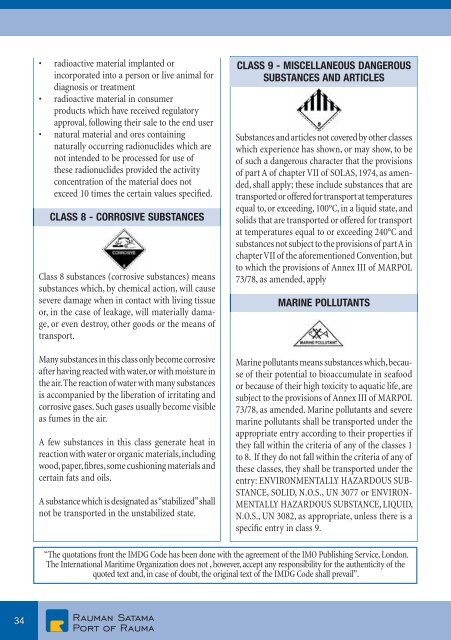2007 - Rauman Satama
2007 - Rauman Satama
2007 - Rauman Satama
You also want an ePaper? Increase the reach of your titles
YUMPU automatically turns print PDFs into web optimized ePapers that Google loves.
34<br />
radioactive material implanted or<br />
incorporated into a person or live animal for<br />
diagnosis or treatment<br />
radioactive material in consumer<br />
products which have received regulatory<br />
approval, following their sale to the end user<br />
natural material and ores containing<br />
naturally occurring radionuclides which are<br />
not intended to be processed for use of<br />
these radionuclides provided the activity<br />
concentration of the material does not<br />
exceed 10 times the certain values specifi ed.<br />
CLASS 8 - CORROSIVE SUBSTANCES<br />
Class 8 substances (corrosive substances) means<br />
substances which, by chemical action, will cause<br />
severe damage when in contact with living tissue<br />
or, in the case of leakage, will materially damage,<br />
or even destroy, other goods or the means of<br />
transport.<br />
Many substances in this class only become corrosive<br />
after having reacted with water, or with moisture in<br />
the air. The reaction of water with many substances<br />
is accompanied by the liberation of irritating and<br />
corrosive gases. Such gases usually become visible<br />
as fumes in the air.<br />
A few substances in this class generate heat in<br />
reaction with water or organic materials, including<br />
wood, paper, fi bres, some cushioning materials and<br />
certain fats and oils.<br />
A substance which is designated as “stabilized” shall<br />
not be transported in the unstabilized state.<br />
CLASS 9 - MISCELLANEOUS DANGEROUS<br />
SUBSTANCES AND ARTICLES<br />
Substances and articles not covered by other classes<br />
which experience has shown, or may show, to be<br />
of such a dangerous character that the provisions<br />
of part A of chapter VII of SOLAS, 1974, as amended,<br />
shall apply; these include substances that are<br />
transported or offered for transport at temperatures<br />
equal to, or exceeding, 100°C, in a liquid state, and<br />
solids that are transported or offered for transport<br />
at temperatures equal to or exceeding 240°C and<br />
substances not subject to the provisions of part A in<br />
chapter VII of the aforementioned Convention, but<br />
to which the provisions of Annex III of MARPOL<br />
73/78, as amended, apply<br />
MARINE POLLUTANTS<br />
Marine pollutants means substances which, because<br />
of their potential to bioaccumulate in seafood<br />
or because of their high toxicity to aquatic life, are<br />
subject to the provisions of Annex III of MARPOL<br />
73/78, as amended. Marine pollutants and severe<br />
marine pollutants shall be transported under the<br />
appropriate entry according to their properties if<br />
they fall within the criteria of any of the classes 1<br />
to 8. If they do not fall within the criteria of any of<br />
these classes, they shall be transported under the<br />
entry: ENVIRONMENTALLY HAZARDOUS SUB-<br />
STANCE, SOLID, N.O.S., UN 3077 or ENVIRON-<br />
MENTALLY HAZARDOUS SUBSTANCE, LIQUID,<br />
N.O.S., UN 3082, as appropriate, unless there is a<br />
specifi c entry in class 9.<br />
“The quotations front the IMDG Code has been done with the agreement of the IMO Publishing Service, London.<br />
The International Maritime Organization does not , however, accept any responsibility for the authenticity of the<br />
quoted text and, in case of doubt, the original text of the IMDG Code shall prevail”.


